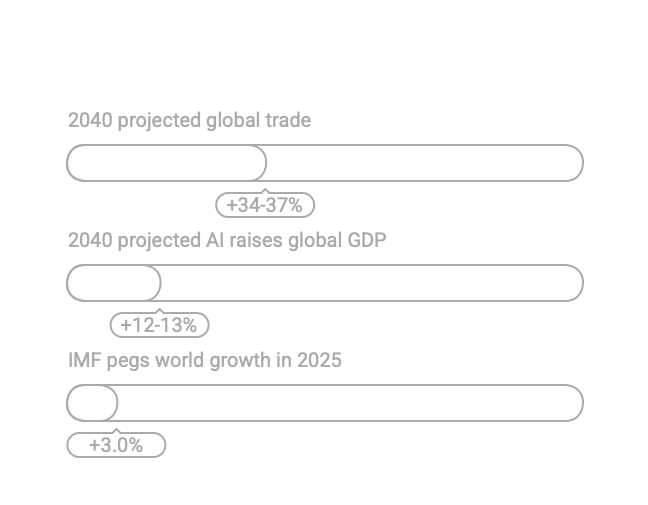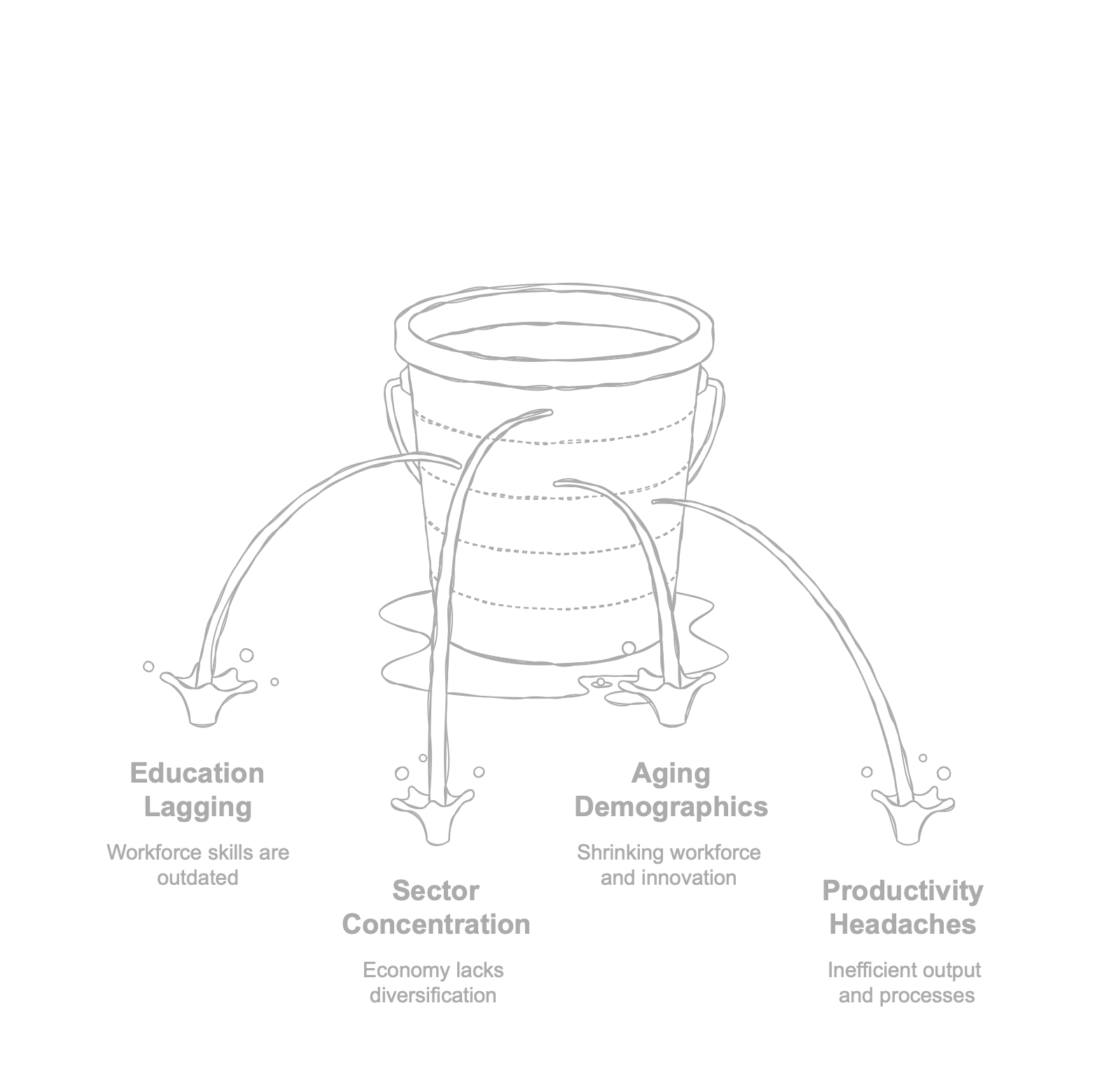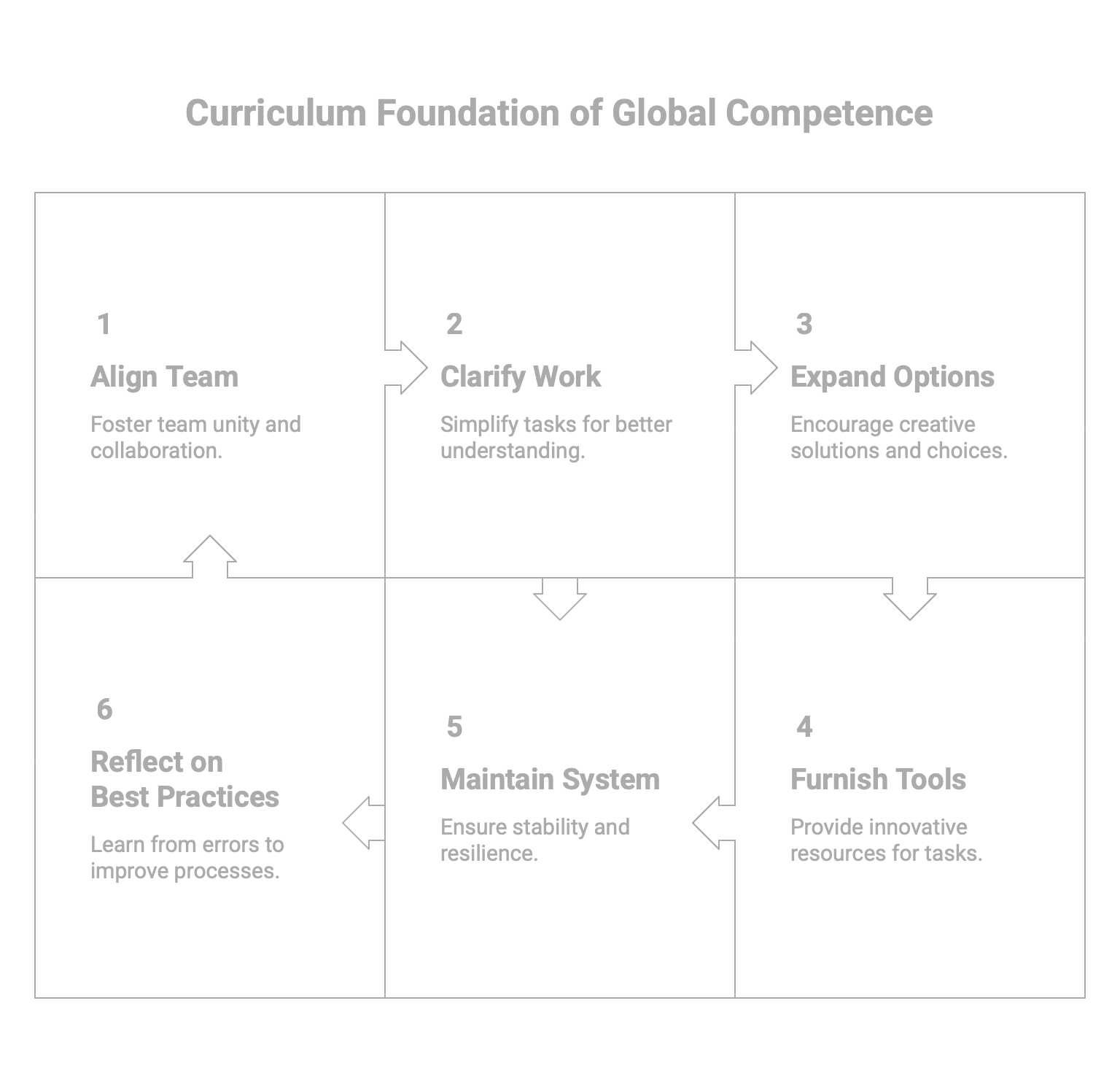At the turn of the millennium, the dominant story was linear: deeper integration, faster trade, cheaper goods, higher living standards. Even today, you still hear the techno-optimist refrain — AI will turbocharge commerce by a third and lift global output well into double digits over the next fifteen years. The World Trade Organization’s new modeling is explicit: if countries build the right pipes — skills, infrastructure, rule-making — AI could expand global trade by roughly 34–37% and raise global GDP by 12–13% by 2040. That’s the projection. The present, however, is more hesitant. The IMF pegs world growth at about 3.0% in 2025 — respectable, but hardly the supercycle of old — and the WTO’s trade outlook is a patchwork of front-loaded imports, tariff detours, and tempered expectations for 2026. Meanwhile, the World Bank keeps ringing a quieter bell: the 2020s are tracking as the slowest decade for global growth since the 1960s outside of outright recessions. We had hoped for a frictionless glide into abundance; instead, we got a rerouting under pressure. World Bank+3World Trade Organization+3IMF+3

That rerouting shows up not only in spreadsheets but in the way families plan lives. For example, in northern Europe and beyond, the 1990s promise — cheaper imports from China, a larger European labor pool, “everyone wins” — masked domestic winners and losers. Professionals with strong credentials captured most of the gains, while regions anchored in tradable mid-skill work absorbed the shocks. When the shocks came faster — financial crisis, pandemic, war, tariff cycles — the operating model shifted from “cheapest” to “most resilient.” Reshoring, near-shoring, and “friend-shoring” are now the grammar of supply chains. The WTO’s own documents read like a travelogue of detours: modest trade growth this year, softer next year as tariffs bite, and a standing warning that unless access is broadened, AI will amplify the very inequalities the 1990s already revealed. That is the gap between projection and landing. World Trade Organization+2World Trade Organization+2
When economies stumble, education becomes the shock absorber — without a shock budget. We expanded universities, celebrated “global citizenship,” and told classrooms to smooth out globalization’s rough edges. But the job market was asking for something more prosaic and, frankly, more demanding: supply-chain literacy, export controls and compliance, data governance, energy-transition know-how, and AI-for-operations that actually moves goods, not just slides. The OECD has documented stubborn skills mismatches for years, and the policy pendulum on international student visas turned a revenue hedge into a source of volatility. The result is a mismatch between what many programs certify and what regional economies need to hire. World Bank
Nowhere does this tension read more clearly than in the EU’s south — Greece, Italy, Spain, Portugal — where the rise, fall, and reconfiguration of globalization have been a lived experience. After the euro-crisis years, Southern Europe surprised many observers with a recovery that at times outpaced the continent’s traditional engine, Germany. Tourism roared back, energy diversification and EU recovery funds poured in, and the region rediscovered some of its economic initiative.

Yet beneath the rebound, the foundations remain delicate: education lagging, sector concentration, aging demographics, and productivity headaches that no single season of tourists can fix. This is a story of genuine improvement tempered by structural gravity. Financial Times+1
The labor market numbers tell the same double-edged story. Eurostat puts EU youth unemployment at 14.4% in July 2025, a welcome tick down from June; Italy reported a sharper improvement, with youth unemployment at 18.7% — still high, but moving the right way. And yet the NEET share — the young neither in work nor education — remains elevated in parts of the south: Greece and Italy sit among the EU’s highest, above a still-too-high EU average of 11% in 2024. Add to that the living-standards gap: by Eurostat’s purchasing-power measure, Greece remains among the lowest in the EU relative to the average, with Italy and Portugal below 100 and Spain hovering near but still under the mean. Recovery is real, but the distance to close is real too. European Commission+3European Commission+3Reuters+3
Classrooms absorb these contradictions in quiet ways. A secondary school in Thessaly prints posters extolling global competence while nearby employers ask for technicians who can maintain wind turbines, run quality controls in a food-processing line, or prepare export documentation that won’t get a shipment stuck in Rotterdam. A university faculty in Campania fills lecture halls with international relations majors even as local clusters beg for graduates who can manage an MES dashboard, interpret sustainability reporting under CSRD, and thread a product through three jurisdictions. Education — rather than being parochial — needs to become more global in the practical sense: teach the rules, the paperwork, the standards, the software, and the ethics that make cross-border business durable when politics bargain hard. World Trade Organization
This is not just a European story. In the United States, the long tail of the “China shock” met a new map of North American integration. Mexico is the top U.S. trading partner, factories are relocating or expanding along the border, and the CHIPS push is creating a labor market where the scarce hires are as often high-skill technicians and compliance specialists as PhDs. Programs that connect students with real-world fabs, logistics hubs, and export paperwork are quietly outperforming generic business degrees because they translate directly into the flow of goods, data, and quality. The old promise of globalization — “learn theory, the market will do the rest” — is being replaced by a craft ethos: learn the rules, learn the tools, then ship. IMF
Across the Atlantic, the UK and the EU are both rewriting their social contracts with universities. For a decade, international tuition propped up budgets; then visa policy whiplashed, geopolitics intruded, and mobility flows became spiky. The most resilient institutions are those that anchor themselves in regional clusters — ports and maritime tech in Iberia, renewables in Greece, medtech in Emilia-Romagna — while maintaining a truly international approach: joint labs, virtual cross-border projects that earn credit, and short, targeted residencies that add value even when travel is limited. It’s internationalization by curriculum design, not just by passport count. World Trade Organization
Shift the lens east, and the plot changes again. China’s “dual-circulation” strategy asks schools to couple domestic resilience with global standards fluency. India’s production-linked incentives are redrawing supply chains in electronics, EVs, and solar, and ASEAN’s “China-plus-one” moment is no longer about cheaper assembly but about supplier upgrading — language, statistics for process control, digital factory tools, vendor development. Africa’s continental free trade project, AfCFTA, is an educational opportunity disguised as a tariff schedule: customs literacy, port logistics, cross-border services, and regional accreditation are the skills that make a single market more than a slogan. The lesson is consistent: globalization hasn’t ended; it has become homework.
What, then, would it mean for education to stop papering over globalization and start powering it fairly? It begins by making geoeconomics and supply-chain literacy core, not elective. Students should learn how tariffs, sanctions, and rules of origin reshape a product’s path, how sustainability reporting intersects with procurement, and how AI tools — from translation to computer vision to routing — reduce the cost of trust in trade. The capstone shouldn’t be a slide deck; it should be a documentation bundle that could clear customs. In parallel, the prestige ladder needs a rebuild. High-quality vocational and polytechnic routes — advanced manufacturing, energy systems, maritime logistics, compliance and data operations — must sit shoulder-to-shoulder with university pathways. The way to dignify them is simple: tie them to hiring consortia and assess them on placement into cluster jobs, not on workshop attendance. World Trade Organization
For Southern Europe specifically, the RRF funds are a once-per-generation flywheel. Use them to modernize teacher capacity — with micro-credentials in trade policy, data governance, and AI-for-operations — and to underwrite short faculty residencies in ports, SEZs, logistics parks, energy sites, food labs, and medtech manufacturers. Reserve subsidized seats for returnees from the diaspora and pair them with relocation grants for employers who hire them into cluster jobs. If you want to reverse brain drain, make the workhigh-order and the on-ramps real. Financial Times

The final mental shift is about measurement. We love vague rubrics—global citizen, innovative mindset—but employers hire on performance. Can you route a shipment through three regimes? Can you produce a vendor code that satisfies a buyer's audit? Can you interpret an energy-system fault and document a fix? Can you use an LLM safely to draft an export declaration and then verify it against the proper authority? When schools measure those things, economies begin to absorb shocks with grace instead of panic.
But measurement shouldn't collapse into a sterile checklist. It must be rooted in connection. Learning is no longer a solo sprint; it's a relay across borders, time zones, and disciplines. A meaningful assessment might ask a logistics team in Thessaloniki to coordinate with a quality group in Porto and a compliance pair in Poznań to move a perishable shipment legally and on time. The artifact isn't a poster—it's the bill of lading that clears, the temperature logs that hold, the audit trail that passes scrutiny. When students practice building and sustaining these ties, they don't seize up when a link fails; they reroute, reassign, and keep goods—and trust—moving.
Connection only carries weight if paired with simplicity. The modern economy is built atop tangled rules, but the practitioners who win are the ones who carve a clean path through the thicket. Schools should require students to translate a 20-step customs maze into a three-page standard operating procedure, complete with a single decision tree, a dashboard, and an unambiguous escalation path. The test is whether a newcomer can run the process from that artifact. Simplicity is not about dumbing down; it's about the disciplined compression of knowledge into actions that reduce handoffs, shorten cycle time, and lower error rates.
Simplicity makes room for creativity—the ability to turn constraints into options. Give learners a broken bill of lading, a late truck, a port strike, and a carbon cap. Ask them to re-sequence tasks, renegotiate Incoterms, and switch to a rail-plus-short-sea route without blowing cost or emissions targets. Creativity here isn't flair; it's option generation under pressure, supported by comparative estimates, risk scoring, and time-to-decision. When students learn to produce viable alternatives on demand, they stop treating shocks as dead ends.
From creativity flows innovation. Ideas become tools that reduce friction: a validation script that cross-checks HS codes against restricted-party lists; a computer-vision routine that flags packaging defects before loading; an LLM workflow that drafts export docs, highlights anomalies, and hands off to a human for final sign-off. Innovation isn't the demo; it's the throughput gain, the defect reduction, the higher audit pass rate, and the way human oversight is built into every loop. Students should be graded on these operational lifts—not just on novelty, but on safety, compliance, and repeatability.
None of this holds without resistance—the resilience to withstand stress and rebound quickly. Build shocks into the grading: a sudden tariff hike, a data-center outage, a supplier non-conformance. Award the highest marks not to the teams that avoid problems, but to those that absorb them with minimal customer impact: pivoting to friend-shored suppliers, activating fallback data pipelines, communicating changes clearly to buyers and authorities. Resistance shows up in the mean time to recovery, continuity of service, and the stable trust of counterparties, even when conditions deteriorate.
Close every cycle with reflection. Require after-action reviews that quantify variance between plan and actuals, identify missed signals, and separate reversible from irreversible decisions. Ask students to document where the model misled the human—or the human misled the model—and to institutionalize one process upgrade in the run book. Reflection turns error into a method. It's how organizations compound learning instead of reliving the same crisis.

When connection aligns the team, simplicity clarifies the work, creativity expands options, innovation furnishes tools, resistance keeps the system upright, and reflection converts mistakes into institutional memory, "global competence" stops being a slogan and becomes something you can ship: throughput, quality, compliance, and trust. That is teachable. That is gradable. And that is how schools help economies flex rather than fracture when the world shifts under their feet.
The story we grew up with said globalization was a tide that lifted all boats. The story we're living says tides change, and so must the hull. AI may yet deliver the gains the models promise, but only if more people and more regions possess the rules fluency and operational craft to participate. That is an education project first, an export project second. The 1990s promised costless integration; the 2020s demand competent integration — naming winners and losers up front, funding transitions, and designing curricula that move products, not just ideas. We missed the turn once. Let's teach the map this time. By the numbers, that map is clear. The IMF projects global growth of about 3.0% in 2025—steady but far from the early-2000s surge—while the World Bank warns that, at current trends, the 2020s could be the slowest growth decade since the 1960s; in that environment, performance-ready skills matter more than slogans. IMF+2World Bank+2 .
The WTO's latest modeling suggests AI could lift global trade by roughly 34–37% and GDP by 12–13% by 2040—but only if countries invest in inclusion and digital infrastructure; otherwise, the gains skew to already-advantaged regions, reinforcing why schools must teach rules-fluency and operational craft, not abstractions alone. World Trade Organization+2Reuters+2 In Europe's south, youth unemployment has improved yet remains a structural risk—14.4% across the EU in July 2025 and 18.7% in Italy—while NEET shares stay elevated and GDP per capita in Greece and several peers remains below the EU average, underscoring the need for curricula tied to real clusters and jobs. European Commission+3European Commission+3Istat+3 Finally, dependence on international tuition has proven volatile. In the UK, student-dependent visas fell 83% year-over-year to March 2025 after policy changes, a reminder that "globalization by enrollment" is fragile unless academic programs create value that travels even when mobility doesn't.



%402x.svg)


%401x.svg)